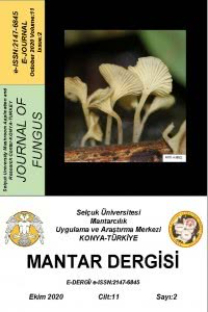Ege Bölgesindeki Domates Patojeni Fusarium oxysporum’un Vejetatif Uyumluluk Gruplarının Belirlenmesi İle Genetik Çeşitliliğ Saptanması
Fusdarium oxysporum, Vejetatif uyumluluk, Fungus, Domates
Determination of Genetic Diversity by Classification of Vegetative Compatibility Groups of Tomato Pathogen Fusarium oxysporum in Aegean Region
Fusarium oxysporum, Vegetative compatibility, Fungus, Tomatoes,
___
- Alborch, L., Bragulat, M.R. and Cabanes, F.J. (2009). Comparison of two selective culture media for the detection of Fusarium infection in conventional and transgenic maize kernels, Applied Microbiology, 50 (3) 266-294.
- Bacon, C. W., and Yates, I. E. (2006). Endophytic root colonization by Fusarium Species: 21 Histology, plant interactions, and toxicity. In Microbial Root Endophytes, Springer Berlin Heidelberg, 133–152.
- Glass, N.L., Jacobson, D.J. and Shiu, P.K. (2000). The genetics of hyphal fusion and vegetative incompatibility in filamentous ascomycete fungi. Annual Review of Genetics, vol. 34, 165-186.
- Gordon, T. R. and Martyn, R. D. (1997). The evolutionary biology of Fusarium oxysporum, Annu. Rev. Phytopathol., vol. 35, 111–128.
- Ignjatov M., Milošević D., Nikolić, Z., Gvozdanović-Varga, J., JovičićGordana Zdjelar J. (2012) Fusarium oxysporum as causal agent of tomato wilt and fruit rot, Pestic. Phytomed., 27(1), 25–31.
- Klein, K.K., Correll, J.C. (2001). Vegetative compatibility group diversity in Fusarium. In B.A. Summerell, J.F. Leslie, D. Backhouse, W.L. Bryden, & L.W. Burgess (Eds.), Fusarium - Paul E. Nelson Memorial Symposium, 392.
- Klıttıcht, C.J.R., Leslıe, J.F. (1999) Chlorate-resistant, nitrate-utilizing (crn) mutants of Fusarium, Journal of General Microbiology, 721- 727.
- Krnjaja, V., Lević, J., Stanković, S., Vasić, T. (2013). The use of vegetative compatibility tests for ıdentification of biodiversity of phytopathogenic fungi, Pestic. Phytomed., 28 (3), 157–165.
- Leslie, J.F. and Summerall, B.A. (2006). The Fusarium Laboratory Manual, Blackwell Publishing, 388.
- Leslie, J.F., (1993). Fungal vegetative compatibility, Annual Review of Phytopathology, 31, 127-150.
- Moore, D., Robson, G.D., Trinci, A.P.J. (1978). 21st Century Guidebook to Fungi, Second Edıtıon, Cambridge University Press 7.5, 1-7.
- Okungbowa, F. I., Shittu, H. O. (2012). Fusarıum wılts: an overvıew, Environmental Research Journal, 6 (2) 122-134.
- Pál, K., Diepeningen, A.D., Varga, J., Hoekstra, R.F., Dyer, P.S., & Debets, A.J.M. (2007). Sexual and vegetative compatibility genes in the aspergilli, Studies in Mycology, vol. 59, 19-30.
- Puhalla, J.E. (1985). Classification of strains of Fusarium oxysporum on the basis of vegetative compatibility, Canadian Journal of Botany, 63(2), 179-183.
- Samson, R.A., Houbraken, J., Thrane, U., Frisvad, J.C., Andersen, B. (2010). Food and indoor fungi, CBS Laboratory Manual Series, 192-193.
- Zainudin, N.A.I.M., Ismail, N.A., Nor, N.M.I.M., Razak, A.B., Sidique, S.N.M., Salleh, B. (2009). Nıtrate non-utılızıng mutants and vegetatıve compatıbılıty groups of Fusarıum prolıferatum and f. saccharı ısolated from rıce ın the penınsular malaysıa and kalımantan, ındonesıa, Journal of Plant Protectıon Research, 49 (2) 233-238.
- Zhao M., Ji H., Gao Y., Cao X., Mao H.Y., Ouyang S-Q. (2018). An integrated analysis of mRNA and sRNA transcriptional profiles in tomato root: Insights on tomato wilt disease, PloS ONE, vol. 13(11), 238.
- ISSN: 2147-6845
- Yayın Aralığı: Yılda 2 Sayı
- Başlangıç: 2010
- Yayıncı: Selçuk Üniversitesi Mantarcılık Uygulama ve Araştırma Merkezi Müdürlüğü
Konya Selçuk Üniversitesi Hastanesi’ne Başvuran Hastalarda Saptanan Dermatofitler
Ekin ERYILMAZ, Rugıyya SAMADZADE, Salih MAÇİN, Duygu FINDIK
Türkiye’de Kültür Mantarı Üretimi ve Teknolojik Gelişmeler
Bazı Uygulamaların Mantar Muhafazasında Kullanımı
Melek EKİNCİ, Ertan YILDIRIM, Atilla DURSUN
Doğal Ortamdan Toplanan Lepista irina (Fr.) H.E. Bigelow’nın Yağ Asidi İçeriğinin Belirlenmesi
İbrahim TÜRKEKUL, Aydın Şükrü BENGÜ, Handan ÇINAR YILMAZ, Hakan IŞIK
Merve KOÇAK, Sinan AKTAŞ, Fatih DURMAZ
Hericium erinaceus (Bull.) Pers. İçin Yüksek Verimli Hibrit Bireylerin Belirlenmesi
Erbil KALMIŞ, Mehmet ATMACA, Fatih KALYONCU
Morchella esculenta ve Trametes versicolor’un İn Vitro Antimikrobiyal Aktivitesi
Kerem CANLI, Atakan BENEK, Merve ŞENTURAN, İlgaz AKATA, Ergin Murat ALTUNER
Eskişehir İli Tarım Topraklarındaki Isıya Dirençli Toprak Mikrofunguslarının Biyoçeşitliliği
Fatma AYVA, Goulsoum OUZEİR, Rasime DEMİREL, Burhan ŞEN, Ahmet ASAN, Duygu KADAİFÇİLER
Butyriboletus fuscoroseus; Türkiye Mikotası için Yeni Bir Boletoid Makrofungus Kaydı
